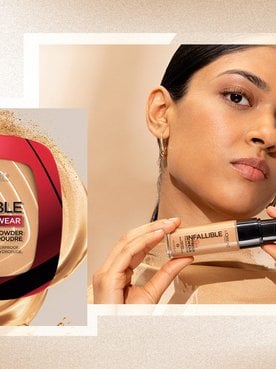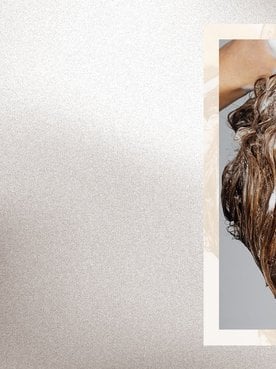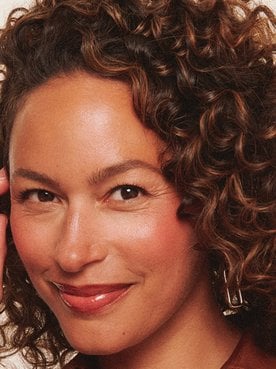If you’ve ever found yourself standing in the makeup aisle, wondering “What colors look best on me?” you’re not alone. But you don’t have to swatch every eyeshadow in the store to find your answer—you can use seasonal color analysis to narrow down your options.
This technique, recently made viral on TikTok, categorizes people into seasonal palettes (Spring, Summer, Autumn, and Winter) based on their skin tone, hair color, and contrast levels. While it’s often used to guide fashion choices, color analysis can be just as useful for finding makeup. The right shades don’t just look good—they can brighten your complexion, add balance, and simplify your routine. Ahead, we’ll walk through a seasonal color analysis guide so you can discover the makeup that truly flatters you—no guesswork needed.
What Is Seasonal Color Analysis?
Seasonal color analysis is a system that helps identify which shades of makeup and clothing naturally complement your features. It groups people into four main “seasons”—Spring, Summer, Autumn, and Winter—based on their skin tone, hair color, and eye color. Each season is then further broken down into three categories based on three key factors: undertone (warm vs. cool), value (light vs. deep), and chroma (muted vs. bright). The result is a personalized palette that makes it easier to know which colors will enhance your complexion instead of overwhelming it.
Although the concept first took shape in the 1980s, it’s had a major resurgence recently thanks to TikTok, where creators use makeup color theory to break down why certain lipsticks, eyeshadows, or blush shades just seem to “click.” Color analysis is often done by a professional, but you can find your season on your own, too—you just need to know what to look for (more on that later).
What Are The Benefits of Knowing Your Color Season?
Knowing your color season can help you determine which colors look best on you, but there are benefits that extend beyond that. Here are a few reasons why doing a seasonal color analysis may be worth your time:
- Enhancing your features: Wearing shades that align with your color season makes your skin appear brighter, your eyes more vibrant, and your overall look youthful. The right colors highlight your natural beauty rather than competing with it.
- Simplifying your routine: Knowing your palette takes the guesswork out of selecting shades. It narrows down the lipstick, eyeshadow, and blush shades that flatter you, making your beauty routine easier in the long run.
- Boosting confidence: Understanding your color season gives you subtle but powerful confidence. Whether putting together a makeup look or planning an outfit, it can help you make choices that allow you to put your best self forward.
The Four Seasons of Color Analysis
Now that you know the basics, we’ll dive a bit deeper into the different color seasons and explain how to determine yours. Keep reading for the details, plus tips on the best colors to complement your complexion.
Spring
The spring color season is characterized by warmth and light. Those who fall into this category typically have warm-toned skin, golden blonde or light brown hair, and bright blue, green, or hazel eyes. You can further break down where you fall in the spring category by assessing the intensity of your skin and eye color, as well as the level of contrast between your hair and complexion.
- Light spring: Light springs typically have fair skin with lighter eyes and hair, and there’s minimal contrast between features.
- True spring: The skin has noticeable warm undertones, and there’s some contrast between features.
- Bright spring: The skin has less distinct warmth, and there tends to be a lot of contrast between hair, skin, and eye color. These features can be fair or deep—what matters most is the contrast and intensity.
When it comes to makeup and clothes, springs typically look best in warm-toned hues—think peaches, corals, and warm golds. If you’re a light spring, you’ll find that pastel tones tend to complement your coloring best; bright springs, meanwhile, can experiment with more vivid, vibrant hues.
To complement your complexion, try reaching for a warm, peachy blush, such as the L’Oréal Paris Lumi Le Liquid Blush in Glowy Gold Pink. You can pair it with a pinky-nude lip gloss (we love the L’Oréal Paris Plump Ambition Hyaluron Lip Oil in Latte Glacé) for a fresh look perfect for everyday. If you want to experiment with something a bit bolder, try pairing a bare face with bright pink eyeshadow. The L’Oréal Paris Paradise Le Shadow Stick in Cloudy Rose gets our vote—it’s the perfect petal pink hue for making your complexion glow.

Shop the Products
Summer
The summer color season is characterized by coolness and softness. People in this category usually have cool-toned skin with pink or rosy undertones, ash blonde or cool brown hair, and blue, gray, or light green eyes. What ties summers together is an overall muted, blended look, where the features have a softer contrast compared to other palettes. You can further determine your placement within the summer category by looking at the depth of your coloring and the level of contrast between your hair, skin, and eyes.
- Light summer: Light summers typically have light, cool-toned skin, hair, and eyes. Contrast is minimal, so the overall effect is airy and, well, light.
- True summer: True summers have distinctly cool undertones and moderate contrast between features. The most common eye colors for true summers include blue, green, and hazel.
- Soft summer: This subtype is the most blended, with muted tones across skin, hair, and eyes.
When it comes to makeup and clothes, summers are flattered by cool, muted shades—think silvers, pale purples, light blues, and soft grays. To make your complexion pop, try pairing a silvery cream highlighter, like the L’Oréal Paris Lumi Le Glass Highlighter Stick in Glowy Crème Chic, with a soft petal-pink lipstick, such as the L’Oréal Paris Colour Riche Satin Lipstick in Montmartre. Or, go for a statement eye with a cool lavender-toned eyeshadow, like the L’Oréal Paris Paradise Le Shadow Stick in Magnetic Mauve. Just be sure to avoid anything too vibrant or pigmented—high-intensity shades can wash out your complexion rather than illuminate it.

Shop the Products
Autumn
The autumn color season is characterized by warmth and depth. Those who fall into this category often have golden or olive-toned skin, rich brown, auburn, or dark blonde hair, and green, hazel, or warm brown eyes. Compared to spring, autumn coloring is deeper and more earthy, with features that tend to have stronger contrast and richness. You can refine your placement within the autumn palette by considering the depth or intensity of your features.
- Soft autumn: Soft autumns have warm skin and hair, typically in muted earth tones such as golden bronde or copper brown.
- True autumn: True autumns show clear warmth in their undertones and have a moderate level of contrast between their hair, skin, and eyes. Those in this category may be described as looking naturally tan.
- Deep autumn: Deep autumns have dark hair and eyes, warm-toned skin, and significant contrast between their features.
When it comes to makeup and clothes, autumns look best in warm, earthy tones (including those you’d likely see on a stroll through the park in late October). For a daytime look that’ll bring out your skin’s natural warmth, try pairing a peachy-gold blush, like the L’Oréal Paris Lumi Le Liquid Blush in Dewy Rich Coral, with brown eyeliner and a glossy nude lip. After dark, take your makeup look up a notch with a rich brick-red lipstick. If you need a recommendation, we love the L’Oréal Paris Infallible Lacque Resistance Liquid Lipstick in Café Parisien.

Shop the Products
Winter
The winter color season is defined by coolness and contrast. Like summers, winters have cool undertones in their skin, but the key difference lies in intensity. Where summers appear soft and muted, winters are striking, with sharp contrast between their features. People in this category often have fair or deep skin with cool undertones, dark brown or black hair, and icy blue, green, or deep brown eyes.
- Cool winter: Cool winters, as the name suggests, have distinctly cool-toned features (skin, hair, and eyes). Their features tend to be bright and clear, though contrast between features is on the softer side.
- True winter: True winters have cool-toned skin and a moderate amount of contrast between their features.
- Deep winter: Deep winters tend to have a high amount of contrast between their features—think ultra-fair, cool-toned skin and jet-black hair.
Generally speaking, winters fare best with rich cool-toned hues, such as emerald green, navy blue, fuchsia, and blue-reds. The intensity of these deep vivid hues play nicely with the natural contrast in your skin and hair. For example, you could make your eyes pop by sweeping on a deep hunter green eyeshadow, like the L’Oréal Paris Paradise Le Shadow Stick in Twilight Emerald. Or, let your lips be the centerpiece of your look with a classic blue-red lipstick, such as the L’Oréal Paris Colour Riche Satin Lipstick in Le Rouge Paris. Remember that when you’re wearing bold colors, it’s best to keep the focus on one feature to avoid overpowering your look.

Shop the Products
How To Determine Your Color Season
If you’re looking to do a color analysis for makeup to find your ideal palette, there are two approaches you can take: the self-guided approach, and the professional route. We’ll break down both, below.
DIY seasonal color analysis
To determine your color season at home, you’ll want to assess your skin tone, undertone, hair color, and the color of your eyes. Natural lighting is key, so step outside or near a window to get the most accurate view. This will help you identify whether you’re warm-toned (Spring or Autumn) or cool-toned (Summer or Winter). Then, compare how different shades of clothing or makeup make your skin look, and take note of which hues look best. This will allow you to narrow down your exact season. Finally, assess your overall contrast level and the intensity of your features to determine which of the three sub-seasons matches your coloring best. You could also use color-matching TikTok filters or online quizzes to narrow down your season, though it’s important to keep in mind that some are more accurate than others.
Professional seasonal color analysis
A professional color analysis uses largely the same approach as a self-guided one, the difference being that experts tend to have more tools at their disposal. Usually, they’ll place colored fabrics or swatches near your face to observe how each looks against your skin. They’ll assess your undertones, contrast, and chroma more precisely, and can take into account factors like whether or not you dye your hair. Professionals can also provide guidance on both makeup and wardrobe choices, creating a cohesive palette tailored to your unique coloring. Ultimately, though, the process is similar to what you’d do at home—so if you don’t want to pay a professional to tell you which colors look best on you, the DIY approach is probably your best bet.
FAQs About Seasonal Color Analysis
Can I be between two color seasons?
It’s possible to fall between two seasons, especially if your coloring has features that overlap palettes. The color season is usually showcased as a wheel, and a lot of people fall right on the cusp of two seasons. In these cases, you may find that shades from both seasons complement you, giving you more flexibility in makeup and wardrobe choices.
What colors should I avoid based on my color season?
You should feel free to wear whatever you want, whenever you want, but certain shades may not be flattering depending on your color season. Here are a few examples:
- Spring: In general, it’s best to stay away from overly cool or muted shades like gray, icy pastels, or deep jewel tones—they can wash out your warmth.
- Summer: Avoid overly warm or bright colors like orange or golden yellow, which can overwhelm your soft, cool undertones.
- Autumn: Skip icy or overly cool shades such as silver, cool pinks, or pastel blues, which can clash with your rich, warm coloring.
- Winter: Avoid warm, muted tones like beige, camel, or orange-toned browns that can dull your high-contrast, cool features.
Does seasonal color analysis apply to hair color and fashion?
Seasonal color analysis isn’t just for makeup—it applies to hair and fashion as well. Choosing hair colors, clothing, and accessories that align with your palette can create a cohesive, flattering overall look.
Can my color season change if I dye my hair or tan?
Changing your hair color or tanning can slightly shift how your palette reads. While your natural undertones remain constant, altering the contrast or warmth of your features, even temporarily, can make certain shades more or less flattering, which may affect which colors from your seasonal palette suit you best.
Next Up: Zodiac Makeup: How To Create The Perfect Look for Your Star Sign
Photo courtesy of L’Oréal Paris







